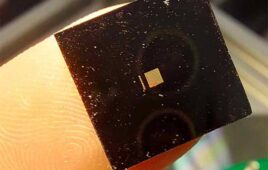
[Image from unsplash.com]
Surgeons go inside the eye with robots
Ophthalmology professor Robert MacLaren and Nuffield Medical fellow Dr. Thomas Edwards performed eye surgery using a remotely controlled robot, lifting a membrane off the retina at the back right of the eye that was 1/100 mm thick. The surgery was performed on the Rev. Dr. William Beaver.
Beaver’s surgery was performed to correct a growing membrane on the surface of his retina that caused his vision to appear as if he was looking in a hall of mirrors at a carnival. The membrane was 1/100 mm thick and needed to be removed without damaging the retina.
The Robotic Retinal Dissection Device (R2D2) operates inside the eye through a small hole that is less than 1mm in diameter. The small hole is needed for R2D2 to enter and exit the eye throughout the entire procedure, regardless if the eye rotates or not.
R2D2 is designed to eliminate the risks involved with tremors that surgeons get, like through their pulse, so that tiny surgical manipulations can be performed within the eye safely. Prior to using the R2D2, surgeons would have to slow their pulse and make precise movements between heartbeats. The robot now enables high-precision procedures that can’t be done by the human hand.
Acting like a mechanical hand, the robot uses 7 independent computer-controlled motors to make precise movements within a 1/1000 mm scale.
The eye surgeon uses a joystick and touchscreen to control the robot and can monitor its progress through an operating microscope.
“There is no doubt in my mind that we have just witnessed a vision of eye surgery in the future,” said MacLaren in a press release. “Current technology with laser scanner and microscopes allows us to monitor retinal diseases at the microscopic level, but the things we see are beyond the physiological limit of what the human hand can operate on. With a robotic system, we open up a whole new chapter of eye operations that currently cannot be performed.”
The new clinical trial will be performed on 12 patients with procedures with varying complexities. R2D2 will peel membranes off of retinas without damaging the retinas in the first part of the trial. If that is successful, the second test will be to see how the robot can place a fine needle beneath the retina and inject fluid through it. The researchers hope that the success of the second test will result in the robot being used for retinal gene therapy and a treatment for blindness.
Synthetic retina offers new hope for visually impaired
A University of Oxford student has developed a synthetic, soft tissue retina that could help treat degenerative eye conditions like retinitis pigmentosa.
Vanessa Restrepo-Schild is a student and researcher in the chemistry department at the university and was the first to use biological, synthetic tissues developed in a laboratory environment to make an artificial retina.
The human retina has protein cells that convert light into electrical signals that travel through the nervous system. Those signals trigger a response in the brain to create a picture of what the eye is seeing. If the retina doesn’t react to light, there is no clear vision.
Restrepo-Schild led a team to develop a synthetic, double-layered retina that resembles the function of the human retina. It has soft hydrogels and biological cell membrane proteins that are able to react to light and create a grayscale image.
“The synthetic material can generate electrical signals, which stimulate the neurons at the back of our eye just like the original retina,” said Restrepo-Schild in a press release.
The cell cultures were created using natural, biodegradable materials and eliminated the use of foreign bodies and living entities. The implant is less invasive than mechanical devices and reduces the chances of a body rejecting the implant.
“The human eye is incredibly sensitive, which is why foreign bodies like metal retinal implants can be so damaging, leading to inflammation and/or scarring,” said Restrepo-Schild. “But a biological synthetic implant is soft and water-based, so much more friendly to the eye environment.”
While the synthetic retina has only been tested in laboratory conditions, Restrepo-Schild hopes to explore its use with living tissues. She hopes to be able to demonstrate how the material is able to be used in a bionic implant.
Restrepo-Schild has filed a patent for the technology and hopes to further develop the device to recognize colors instead of just grayscale. The researchers also hope to expand the research to include animal testing and then clinical trials in humans.
The study was published online in the journal Scientific Reports.
[Want to stay more on top of MDO content? Subscribe to our weekly e-newsletter.]







